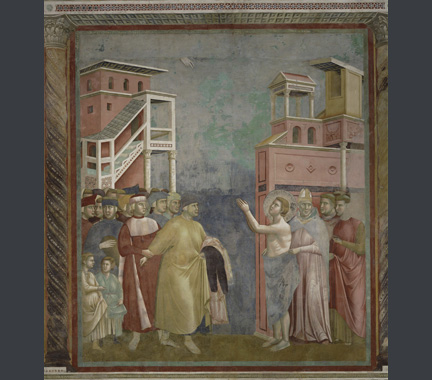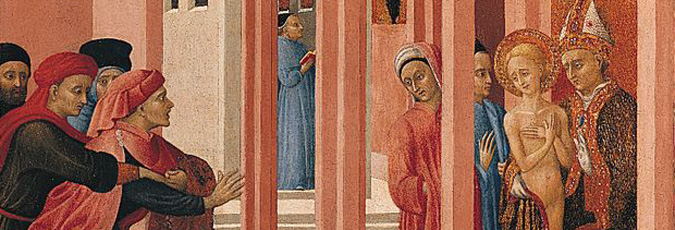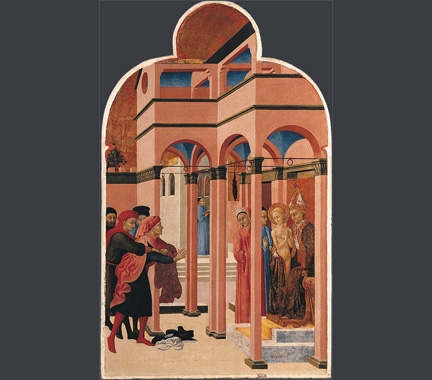Sassetta (active by 1427; died 1450)
'Saint Francis renounces his Earthly Father', 1437–44
Egg tempera on poplar, 87.5 x 52.4 cm
NG4758
This panel is one of seven in the National Gallery from Sassetta's masterpiece, the altarpiece for San Francesco in Borgo Sansepolcro, unfortunately dismantled in the late 16th century. It shows the moment when Saint Francis renounces his father (who had tried to dissuade him from following the religious life) by symbolically removing in public the rich clothes his father had given him and taking naked refuge in the arms of the Bishop of Assisi.1 This picture was originally placed on the back of the altarpiece, which told the story of the life and major miracles of Saint Francis through a series of narrative paintings.2
The architectural setting
The architectural setting in the work, though it consists of only two buildings, is spatially complex, featuring a series of interlinked but distinct zones divided by piers, walls and steps. The principal space is a large cross-vaulted loggia, open on three sides and supported on slender piers with ‘foglie d’acqua’ (water leaf) capitals (seemingly the invention of the artist as they only distantly resemble extant built examples), inside which the enthroned Bishop of Assisi cradles the naked Francis in his arms. Projecting from this main loggia is the porch behind Francis’s father, the outer wall of which is closed and decorated with a frieze. The building as a whole appears to be two storeys, with another smaller loggia, empty of figures, occupying the second floor. Its architectural character is a strange mixture of the invented and the real. The unusual pink and green colouring, possibly inherited from the great Sienese painters of the Trecento such as Duccio, the Lorenzetti brothers and Simone Martini, and the oddly shaped loggia, are rather fantastical features, very different in character from the functional tie rods that span the building’s arches. The second structure in the painting, separated from the first by its grey colour and the steps that lead up to it, appears to be a church, its walls pierced by elegant lancet windows. A solitary blue-robed figure stands here, looking up from his book as if in thought.
The introductory essay to this section discusses how the architecture in this panel is used to symbolise Francis’s decision and its effects. The porch in the middle creates a void in the work, representative of the distance between Francis and his father – a void that is significantly empty of everything save Francis’s discarded clothes, which form a potent symbol of the life that he is leaving behind.

Comparing the panel to another representation of the event in the great fresco cycle dedicated to the life of Saint Francis in the Upper Church of San Francesco in Assisi (fig. 1) reveals one further way in which Sassetta has used his setting to enrich his depiction of this key episode in the saint’s life. In the version at Assisi, painted over 100 years earlier, the painter also created a central void in his scene, in this case by filling each side of the fresco with a collection of buildings while leaving the centre empty. The poses of the figures share much with Sassetta’s work (with Francis’s father being restrained on the left and the bishop embracing Francis on the right, covering his nakedness with his cloak). One new architectural element in Sassetta’s work, however, is the church at the back of the panel. This arguably increases the panel’s narrative richness, allowing Sassetta to depict not only Francis’s decision to renounce his father, but also its consequences, by showing the holy space of the church to which he is heading. If the loggia is a liminal space, a space of decision that is part holy and part secular, then the church, which is wholly sacred, shows the future that it is Francis’s destiny to fulfil.
Selected literature
Trexler 1989; Billinge 2009; Gordon 2009; Israëls 2009.
This material was published in April 2014 to coincide with the National Gallery exhibition 'Building the Picture: Architecture in Italian Renaissance Painting'.
To cite this essay we suggest using
Alasdair Flint, ‘Sassetta, Saint Francis renounces his Earthly Father’ published online 2014, in 'Building the Picture: Architecture in Italian Renaissance Painting', The National Gallery, London, http://www.nationalgallery.org.uk/research/research-resources/exhibition-catalogues/building-the-picture/entering-the-picture/sassetta-saint-francis


